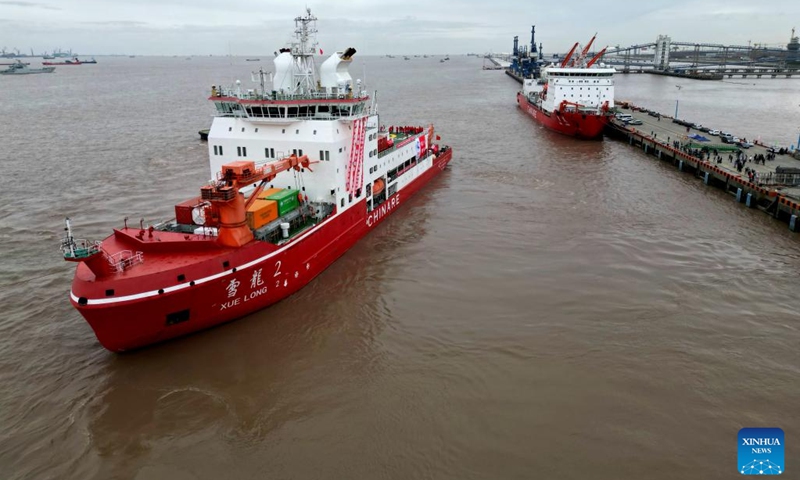Chinese research icebreaker Xuelong kicks off polar expedition, expected to make new contributions to international polar science

China's research icebreaker Xuelong 2, or Snow Dragon 2, sets off for the country's 39th Antarctic expedition from Shanghai, East China, on October 26, 2022. A total of 255 researchers will carry out investigations in the fields of atmospheric composition, water environment, sedimentary environment and the ecosystem at the South Pole, and will arrive in two batches, with the second batch setting out on October 31, 2022. Photo: Xinhua
Chinese research icebreaker Xuelong, or Snow Dragon, set off from Shanghai on Monday, following the footsteps of Xuelong 2, or Snow Dragon 2, to start the third-time polar expedition for China to send two icebreakers to the Antarctic since 2020. It's expected to make new contributions to the development of international polar science and the peaceful use of Antarctica by all mankind.
The expedition mode of two icebreakers starting from the 36th polar expedition in 2020 provides more options in terms of team composition, route planning and task allocation. It has greatly expanded the continuity and coverage of China's Antarctic expedition, improved the efficiency of polar expedition, and effectively enhanced the comprehensive capability of China's Antarctic expedition.
The scientific venture will focus on a range of major scientific issues including the response and feedback of key areas of the Southern Ocean to global climate changes and carry out related researches in the fields of atmospheric composition, water environment, sedimentary environment and oceanic ecosystem investigations at the South Pole.
Meanwhile, environmental monitoring on ice and snow and astronomical observation will be carried out along China's Zhongshan, Taishan and Kunlun stations in the region.
The researchers will use the country's first polar plane, the Xueying 601, or Snow Eagle 601, a fixed-wing aircraft to carry out subglacial terrain exploration in areas such as the Princess Elizabeth Land region of East Antarctica.
Other tasks will include the replenishment of materials and staff rotation at China's Zhongshan Station and Great Wall Station.
With a total length of about 122 meters, a width of about 22 meters, a designed displacement of nearly 14,000 tons and an endurance of 20,000 nautical miles, Xuelong 2 is China's first domestically built icebreaker for polar research.
A total of 255 researchers will participate in the expedition with over 150 members in the second batch setting out on Monday. The first batch set off from Shanghai last Wednesday.
Global Times


